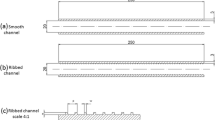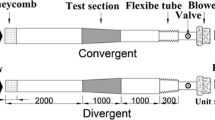Abstract
A computational parametric study of forced convection in two-dimensional ribbed channels was performed. The effects of Reynolds number, element (rib) height, element width, element-to-element spacing and the variation of heat flux distribution of the elements on the average Nusselt number and heat transfer coefficient were determined numerically using commercial Computational Fluid Dynamics package. The results were compared to experimental data obtained from the literature and showed good agreement. Based on this study, the average Nusselt number was correlated to each variable parameter using regression analysis. It was found that the Nusselt number is a strong function of geometric parameters and flow velocity. A major finding of the numerical study was the negligible effect of heat flux profile on the average Nusselt number.

Similar content being viewed by others
References
Luo, D.D.; Leung, C.W.; Chan, T.L.; Wong, W.O.: Flow and forced-convection characteristics of turbulent flow trough parallel plates with periodic transverse ribs. Numer. Heat Transf. Part A. 48, pp. 43–58 (2005)
Yeh, L.T.; Chu, R.C.: Thermal management of microelectronic equipment. ASME Press, New York (2002)
Schmidt, R.: Challenges in electronic cooling-opportunities for enhanced thermal management techniques-microprocessor liquid cooled mini-channel heat sink. Heat Transf. Eng. 25(3), pp. 3–12 (2004)
Rodgers, P.; Eveloy, V.; Pecht, M.G.: Limits of air-cooling: status and challenges. In: 21st IEEE SEMI-THERM Symposium (2005)
Electronic Cooling Magazine: Managing Power Requirements in the Electronics Industry (2000)
Young, T.J.; Vafai, K.: Convective flow and heat transfer in a channel containing multiple heated obstacles. Int. J. Heat Mass Transf. 41, pp. 3279–3298 (1998)
McEntire, A.B.; Webb, B.W.: Local forced convective heat transfer from protruding and flush-mounted two-dimensional discrete heat sources. Int. J. Heat Mass Transf. 33(7), pp. 1521–1533 (1990)
Jubran, B.A.; Swiety, S.A.; Hamdan, M.A.: Convective heat transfer and pressure drop characteristics of various array configurations to simulate the cooling of electronic modules. Int. J. Heat Mass Transf. 39(16), pp. 3519–3529 (1996)
Leung, C.W.; Kang, H.J.: Convective heat transfer from simulated air-cooled printed circuit board on horizontal or vertical orientation. Int. Comm. Heat Mass Transf. 25(1), pp. 67–80 (1998)
Wang, Y.; Vafai, K.: Heat transfer and pressure loss characterization in a channel with discrete flush and protruding heat sources. Exp.Heat Transf. 12, pp. 1–16 (1999)
Young, T.J.; Vafai, K.: Experimental and numerical investigation of forced convective characteristics of array of channel mounted obstacles. Trans. ASME 121, pp. 34–42 (1999)
Elsaadawy, E.; Mortazavi, H.; Hamed, M.S.: Turbulence modeling of forced convection heat transfer in two-dimensional ribbed channels. IEEE J. Electron. Packag. 130(3), 031011 (2008)
Kays, W.M.; Crawford, M.E.: Convective Heat and Mass Transfer. Third Edition, McGraw Hill Book Company, New York (1993)
ANSYS-Fluent 12.0 Theory Guide (2009)
Molki, M.; Faghri, M.; Ozbay, O.: A correlation for heat transfer and wake effect in the entrance region of an in-line array of rectangular blocks simulating electronic components. ASME J. Heat Transf. 117, pp. 40–46 (1995)
Dhinsa, K.K.; Bailey, C.J.; Pericleous, K.A.: Turbulent modeling and it’s impact on cfd predictions for cooling of electronic components. In: Proceedings of the Ninth Intersociety Conference on Thermomechanical Phenomena in Electronic Systems (2004)
Author information
Authors and Affiliations
Corresponding author
Rights and permissions
About this article
Cite this article
El Nakla, M. Forced Convection Heat Transfer in Two-Dimensional Ribbed Channels with Varying Heat Flux Profiles Using ANSYS’ Software and Modeling. Arab J Sci Eng 39, 2157–2164 (2014). https://doi.org/10.1007/s13369-013-0735-6
Received:
Accepted:
Published:
Issue Date:
DOI: https://doi.org/10.1007/s13369-013-0735-6




